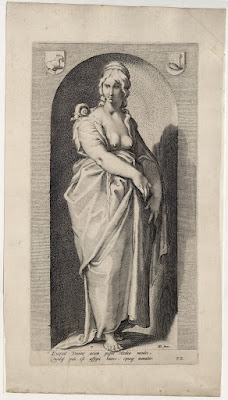Jacopo Caraglio (c.1500–65) and retouched by Francesco Villamena (c.1565–1624)
“Jupiter”, 1526,
after Rosso Fiorentino (1494–1540),
from the series “Mythological Gods and Goddesses”. TIB (vol. 28) advises that
this print is “from the series of second states retouched by Villamena” (p. 123).
Engraving on
fine laid paper with watermark trimmed along the platemark/borderline.
Size: 21.1 x
11.1 cm
Lettered below
the image borderline 'IVPPTER - AETHEREA - SVMMA - DOMINATOR - IN - ARCE 3.”
State ii (of
ii). Note that Villamena added the background of finely engraved lines on the
lit side of Jupiter to Caraglio’s engraving of the first state. (See an
illustration of the first state in TIB, vol. 28, p. 103.)
Bartsch
XV.78.26.3 (Adam Bartsch 1803,”Le Peintre graveur”, 21 vols, Vienna); TIB 28
(17). 26-II (79) (Walter L Strauss Ed. 1985, “The Illustrated Bartsch”, vol.
28, p. 123).
The British
Museum offers the following description of this print which the BM describes as
“after Caraglio”:
“Jupiter
holding a thunderbolt in his left hand riding an eagle emerging from a niche;
from a series of 20 engravings depicting mythological gods and goddesses. 1526
Engraving”
Condition: well-inked,
strong and crisp impression trimmed along the platemark/borderline. The sheet
is lightly age-toned and there are remnants of mounting verso.
I am selling
this exceptionally rare engraving for the total cost of AU$354 (currently US$270.58/EUR253.11/GBP216.58
at the time of this listing) including postage and handling to anywhere in the
world.
If you are
interested in purchasing this museum quality print (note that the quality of
this impression surpasses that held by the BM), please contact me
(oz_jim@printsandprinciples.com) and I will send you a PayPal invoice to make
the payment easy.
This print has been sold
When I was researching this print I found myself being led all over my
library trying to piece together its history. For instance, the British Museum
simply attributes this print as being “after Caraglio” and I can understand
their point as the image seen here is not created entirely by Caraglio (after
Florentino). The plate had been retouched by Villamena whose mission in life
seems to be to retouch all the old master plates that he could get his hands on
so as to “improve” them. I need to be careful in chastising this old master,
however, as Caraglio is well known for “improving” the designs of other
artists, especially in terms of backgrounds. Indeed, Michael Bury (2001) in “The
Print in Italy 1550–1620” gives the following fascinating insight into
Caraglio’s propensity to make improvements:
“Caraglio
worked from a drawing by Rosso Fiorentino which must either have consisted of
the figures alone, or alternatively had a background that Caraglio judged
inadequate for his purpose. It may have been quite common for printmakers to
decide that the creation of a successful print required significant adjustments
to be made to their model, especially with regard to the environment for the
figures” (p. 15).
Regarding this
print, after weaving my way through volume 28 of “The Illustrated Bartsch” (1978)
catalogue raisonné of Caraglio’s prints I counted five variations of it (pp. 103, 123, 143, 162, 173). This may not sound so surprising given that
reproductive prints had a ready market in the 16th century, but
there is one important element that baffles me as to why Florentino’s original
design was not given its proper attribution by Caraglio; namely,
Caraglio is one of the first printmakers to introduce the term “invenit” to be
inscribed on printing plates to clarify who designed the image. Later a whole
raft of terms gave further clarity to distinguish the roles played by the designer
of the image (“Delineavit” in the case of a drawing or “Pinx” if a painting), the
printmaker who cut the plate (“Fecit”), the publisher (“Excuit”) and the
copyright authority (“Cum privilegio”). I just wish that Caraglio had insisted
on having clear information inscribed about this print’s production.




















































